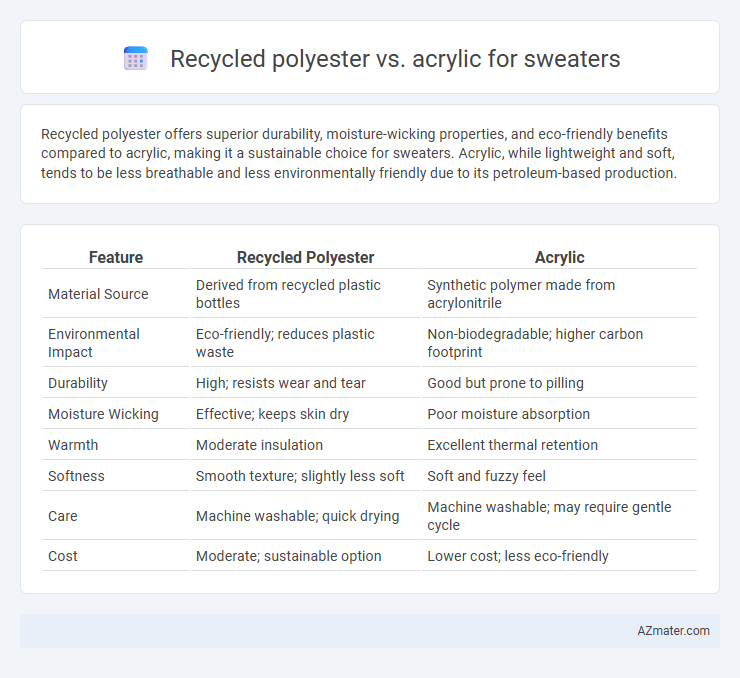Recycled polyester offers superior durability, moisture-wicking properties, and eco-friendly benefits compared to acrylic, making it a sustainable choice for sweaters. Acrylic, while lightweight and soft, tends to be less breathable and less environmentally friendly due to its petroleum-based production.
Table of Comparison
| Feature | Recycled Polyester | Acrylic |
|---|---|---|
| Material Source | Derived from recycled plastic bottles | Synthetic polymer made from acrylonitrile |
| Environmental Impact | Eco-friendly; reduces plastic waste | Non-biodegradable; higher carbon footprint |
| Durability | High; resists wear and tear | Good but prone to pilling |
| Moisture Wicking | Effective; keeps skin dry | Poor moisture absorption |
| Warmth | Moderate insulation | Excellent thermal retention |
| Softness | Smooth texture; slightly less soft | Soft and fuzzy feel |
| Care | Machine washable; quick drying | Machine washable; may require gentle cycle |
| Cost | Moderate; sustainable option | Lower cost; less eco-friendly |
Introduction to Sweater Materials
Recycled polyester and acrylic are popular sweater materials known for their durability and warmth. Recycled polyester is made from post-consumer plastic waste, offering an eco-friendly alternative with moisture-wicking properties and resistance to shrinking. Acrylic provides a soft, lightweight feel while mimicking wool's insulation, making it a cost-effective choice for cozy sweaters.
What is Recycled Polyester?
Recycled polyester is a sustainable fabric made from post-consumer plastic waste such as PET bottles, reducing landfill waste and conserving resources. It offers durability, moisture-wicking properties, and resistance to stretching and shrinking, making it ideal for sweaters. Compared to acrylic, recycled polyester provides better environmental benefits and enhances garment performance with superior breathability and quicker drying times.
Understanding Acrylic Fiber
Acrylic fiber, a synthetic polymer known for its wool-like feel and warmth, offers excellent resistance to moisture, mold, and UV light, making it a popular choice for sweaters. Compared to recycled polyester, acrylic fibers tend to be softer and retain their color vibrancy over time but lack the eco-friendly benefits associated with recycled materials. Understanding these properties helps consumers balance comfort, durability, and environmental impact when selecting sweater fabrics.
Environmental Impact: Recycled Polyester vs Acrylic
Recycled polyester significantly reduces environmental impact by reusing plastic waste and lowering carbon emissions compared to conventional polyester production, while also conserving water and energy resources. Acrylic, derived from petroleum-based chemicals, contributes to higher carbon footprint, non-biodegradability, and microplastic pollution in oceans. Choosing recycled polyester for sweaters supports sustainable textile practices and minimizes ecological damage across the product lifecycle.
Durability and Longevity Comparison
Recycled polyester offers superior durability and longevity for sweaters compared to acrylic, as its synthetic fibers resist stretching, shrinking, and pilling over time. Acrylic tends to lose shape and fade with repeated washing, while recycled polyester maintains color vibrancy and structural integrity through extended use. Choosing recycled polyester sweaters enhances sustainability without compromising on long-term wear performance.
Comfort and Feel: Which is Softer?
Recycled polyester offers a smooth, silky texture that feels lightweight and breathable against the skin, making it a popular choice for eco-friendly sweaters. Acrylic fibers, on the other hand, mimic the softness of wool and provide a warm, plush feel, often preferred for cozy, insulating garments. When comparing softness, acrylic tends to feel fluffier and warmer, while recycled polyester excels in moisture-wicking comfort and smoothness.
Warmth and Insulation Properties
Recycled polyester offers superior warmth and insulation due to its dense fiber structure that traps heat effectively, making it a preferred choice for eco-friendly sweaters. Acrylic fibers provide decent insulation by mimicking wool's natural warmth, but they tend to be less breathable and can retain moisture, reducing the overall thermal performance. For optimal cold-weather wear, sweaters crafted from recycled polyester maintain heat better and wick moisture away, enhancing comfort in chilly conditions.
Ease of Care and Maintenance
Recycled polyester sweaters are highly durable and resistant to wrinkles, making them easy to machine wash and quick to dry without losing shape or color. Acrylic sweaters also offer low-maintenance benefits, being resistant to moths and shrinkage, but they may pill more easily and often require gentler washing cycles. Both fibers provide convenient care options, but recycled polyester typically outperforms acrylic in wrinkle resistance and drying time.
Price and Availability Differences
Recycled polyester sweaters typically offer more affordable pricing due to the growing scale of production and demand for sustainable fabrics, while acrylic sweaters may sometimes be priced higher because of their synthetic fiber quality and manufacturing process. Availability of recycled polyester garments is increasing as brands shift towards eco-friendly materials, whereas acrylic sweaters remain widely accessible but may be less favored in sustainability-focused markets. Price fluctuations for both materials depend on market trends, but recycled polyester demonstrates better potential for cost efficiency and supply chain expansion.
Making the Sustainable Choice for Sweaters
Recycled polyester offers a sustainable alternative for sweaters by reducing plastic waste and lowering carbon emissions compared to virgin synthetic fibers. Acrylic, while soft and warm, relies on non-renewable petroleum resources and has a higher environmental footprint due to energy-intensive production and poor biodegradability. Choosing recycled polyester for sweaters supports circular fashion initiatives and significantly minimizes environmental impact in fabric manufacturing.

Infographic: Recycled polyester vs Acrylic for Sweater
 azmater.com
azmater.com